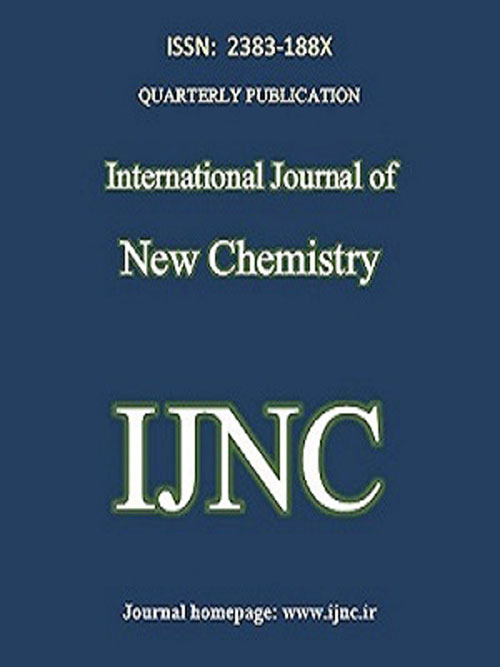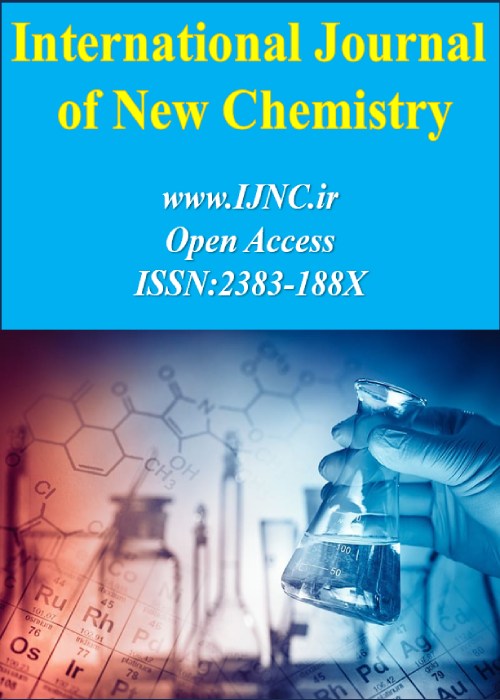فهرست مطالب

International Journal of new Chemistry
Volume:4 Issue: 3, Autumn 2017
- تاریخ انتشار: 1396/09/30
- تعداد عناوین: 5
-
Pages 61-71
In this study, doped vanadium oxide nanotubes were evaluated using different software to study the absorption of hydrogen gas. Vanadium oxide nanotubes are one of the options for absorption and storage hydrogen gas. In this research study for the first time, the Monte Carlo simulation was used to investigate the hydrogen gas absorption behavior in molybdenum-tungsten, molybdenum-zirconium and zirconium-tungsten doped vanadium oxide nanotub. At 300 K and at different pressures, the amount of hydrogen gas absorption inside and outside the doped nanotubes has been investigated. The results show the maximum adsorption capacity in 50MPa. Also, by comparing the obtained data and absorption isotherms, was determined absorption of hydrogen gas in vanadium oxide nanotube doped with zirconium molybdenum was better than the other two nanotubes.
Keywords: Simulation Monte Carlo (MC), Vanadium oxide nanotube (VONT), absorb -
Pages 72-77
In this work, the electronic properties of BP and CSi Nano cones have been investigated by self-consistent reaction field (SCRF) method in water solvent at B3PW91/6-31G (d,p) level of DFT theory for study of for interactions of 5-Fluorouracil Anticancer Drug with theses Nano cones. The percent of change of energy gap (%ΔEg) shows that the complex formation of 5-Fluorouracil with BP nano cone is more suitable.
Keywords: BP Nano cone, CSi Nano cone, 5, Fluorouracil, Nano Carrier, Solvent, DFT -
Pages 78-85
In this research, RDX energy derivatives with different carbon nanoparticles under different temperature conditions were studied using density functional theory. For this purpose, the materials were first geometric optimized, then the thermodynamic parameters were calculated for all of them. Then, the process of changing the energy-dependent parameters such as specific heat capacity, enthalpy, entropy and Gibbs free energy relative to molecular mass, molecular volume and measured level in this study at a given temperature, were evaluated against each other.
Keywords: High energy energy derivatives, Different Carbon Fullerenes, RDX, Functional density theory -
Pages 86-92
In this study, trans-3-butadiene monomer derivatives with different carbon nanoparticles of the same mass (mass mass) under different temperature conditions were studied using density functional theory. For this purpose, the materials were first geometric optimized, then the thermodynamic parameters were calculated for all of them. Then, the process of changing the energy-dependent parameters such as specific heat capacity, enthalpy, entropy and Gibbs free energy relative to molecular mass, molecular volume and measured level in this study at a given temperature, were evaluated against each other.
Keywords: Monomer, Trans-3, Butadiene, Nanoparticles of the same carbon, Fullerene, Functional density theory -
Pages 93-100
In this study, the thermodynamic properties of polyvinyl chloride monomer derivatives, PVC with nanoparticles of fullerene, nanotubes and nano cones at room temperature, were studied by DFT method. For this purpose, the materials were first geometric optimized, then the thermodynamic parameters were calculated for all of them. Then, the process of changing the energy-dependent parameters such as specific heat capacity, enthalpy, entropy and Gibbs free energy relative to molecular mass, molecular volume and measured level in this study at a given temperature, were evaluated against each other.
Keywords: PVC, carbon-containing fullerenes, density functional theory


